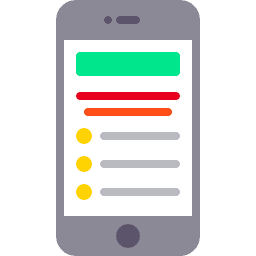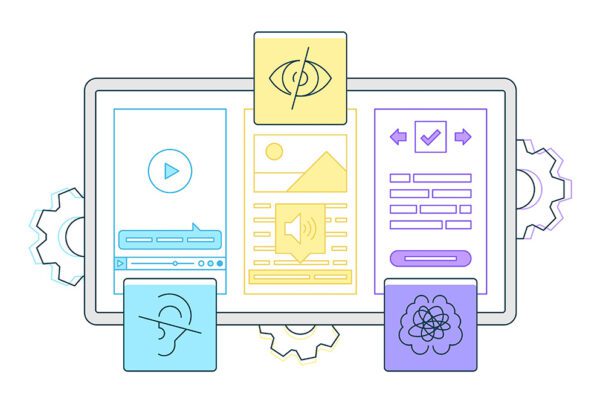A History of Mobile Design
It’s easy to forget that the internet was born in the 90s and that technology in the last few decades has gone from basic Nokia brick cell phones to smartwatches that can receive calls, play music, act as a GPS, and so much more. In short, before we dive into some intricacies of mobile-first web design (i.e. who it works for, who it doesn’t work for, how to determine if it’s right for you, and an alternative to it) let’s first look at a brief history of mobile devices being used for browsing the internet.
Mobile use exploded throughout the 2010s and continued to rapidly evolve during the Covid pandemic.
This dramatic change in the industry from desktop users to mobile users led many web designers and developers to consider the reality that, with so many people on mobile devices, perhaps web design should be exclusively for them.
Enter the theory of mobile-first design.

What Is Mobile-First Web Design?
Let’s first speak to a typical web design process that does not adhere to the mobile-first approach.
A website is designed assuming it will be viewed and interacted with most often on a desktop or laptop computer. Therefore, the initial design effort is put into the desktop version of the site. Once the desktop design is complete, the site is then designed for mobile – more often than not by simply removing certain elements and delivering a more minimal product. This process is sometimes termed “graceful degradation.”
Now let’s speak to the mobile-first approach.
Mobile-first design is exactly as it sounds, designing first for the user experience on the smallest screen size (a phone) and then working your way up to the full desktop experience. The emphasis is placed primarily on the mobile device. This strategy has been called “progressive advancement” or “progressive enhancement.”
While mobile-first design might sound practical in the modern age, however, the decision to adopt a mobile-first approach really isn’t that straightforward.
Designing for Your Audience
The key to any successful marketing initiative, web design included, is understanding your audience. So let’s ask some questions to help us understand if mobile-first web design is the best choice.
On what device do people spend the most time on the internet? Answer: Cell phones.
Is all of the time spent on mobile devices used to browse websites? Answer: Nope. People are watching a lot of Netflix, scrolling social media, or playing games.
So of all website visits, what percentage of traffic comes from mobile? Answer: While this number fluctuates quarter to quarter, one recent study found that 58 percent of all online traffic comes from mobile devices with mobile traffic consistently staying in the 50 percent range.
Finally, on what device do people most often convert (i.e. make a purchase)? Answer: While conversions are dependent on many things beyond just your device, one study found that mobile sales currently stand at 55%, a significant number considering the amount of mobile traffic reported above.
The data above, however, should not be considered in a vacuum.
Consider the following pro-desktop data:
- Although more overall website visits come from mobile devices, more time is spent per site visit on desktops.
- Conversion rates are always impacted by a variety of factors and the data will always look a little different depending on the industry an organization is in.
- Americans are using multiple devices throughout their day and throughout their buyer’s journey.
To expound on point number 3, someone hoping to purchase a smartwatch for the first time may begin researching the devices on a tablet, use a desktop at work to read reviews during a break, browse more on a phone during a daily commute, and finally make a purchase on a personal laptop. In this instance, there was one purchase, four devices, and three primary tasks: general research, product browsing, and the purchase.
So with both desktop and mobile data to consider, how do you choose the best design theory for your website and your users?
Enter Journey-Driven Design
Many in the design community have taken mobile-first design to mean mobile-only design. Because most users’ digital interactions with your company take place on many different devices, mobile-first design isn’t always the right answer.
The strategy of doing research to truly determine what environments your users prefer to perform certain tasks related to your business, and then optimizing for those tasks, is called journey-driven design.
Journey-Driven Design for Small Business
Just because global usage data promotes mobile-first design as the main option doesn’t mean you have to immediately revamp all of your systems. As a small business, national data may not always be accurate in your smaller, local context. Journey-driven design asks the question: what is the best thing for my user base and my business?
Answering that question early on in the web development process and knowing your audience, your product, and your company goals can help you blend elements of mobile-first design and traditional desktop design to find a happy medium between the two. Journey-driven design focuses, as it sounds, on your user’s journey while marrying content strategy with web development. All this puts your user right where you want them: at the center of all of your marketing efforts.
So what does this web design approach look like in practice?
A Brief Guide to Journey-Driven Design
Here are a few simple, initial steps you can take to move toward journey-driven design:
-
- Determine the most important tasks for your company that take place on your website.
Perhaps it’s a purchase or a form submission. Bonus points if you consider the digital touch points that take place off-site, such as email workflows.
- Determine what devices your users are on when completing (or attempting to complete) these tasks.
The best way to do this is to set up your Google Analytics to keep tabs on these conversions. Once you have goals set up, you can drill down on these conversions and see what device was used. If a form fill is mainly completed on a desktop, you should incorporate that into your web design.
- Design for the experience beginning with the most used device.
If you’re reworking the purchasing sequence and the purchase happens most often on a desktop – start your redesign with a desktop. If you’re focused on a form submission that takes place most often on a tablet, make sure the experience is as optimized as possible on a tablet, and go from there.
- Determine the most important tasks for your company that take place on your website.
As more and more devices are introduced to our users, designing for your user and their preferences will become more important than ever. Remember, having a loyal, dedicated customer is far better than measuring up to a global data point or an industry trend.
Start the Conversation
Interested in learning more about web design and our individualized process?









